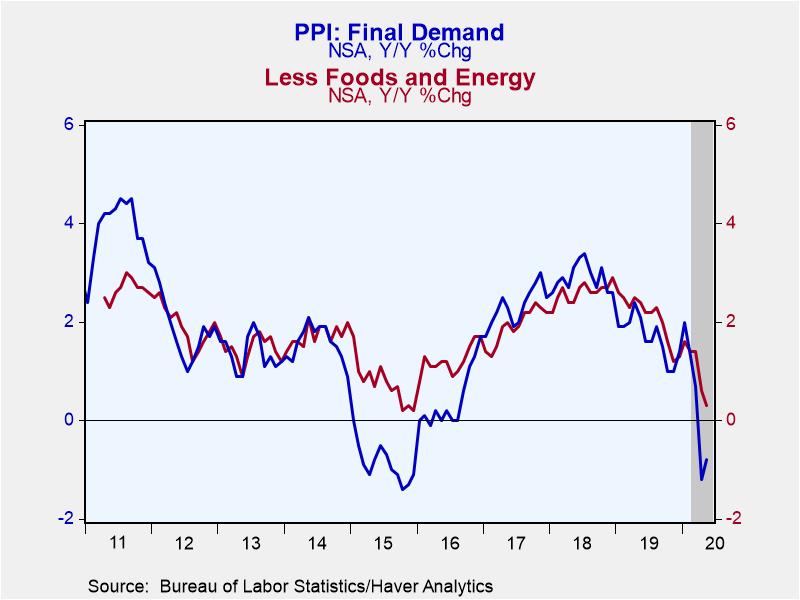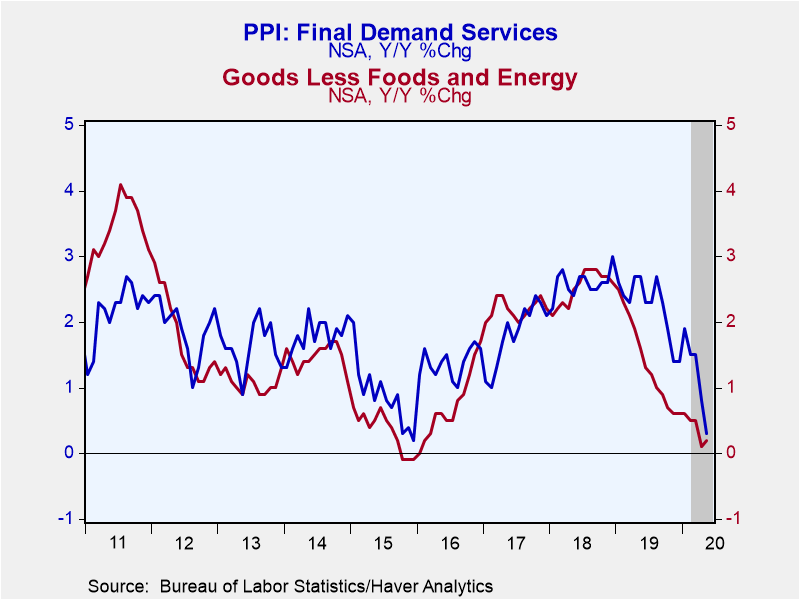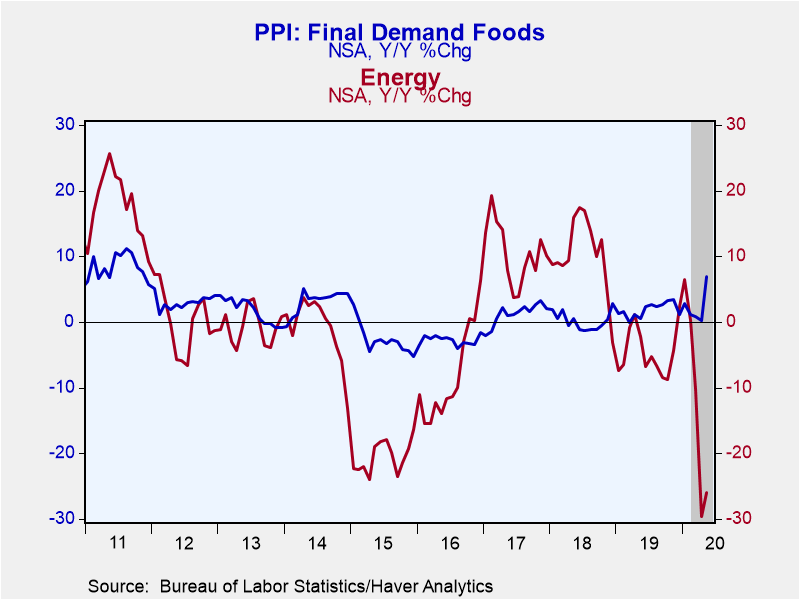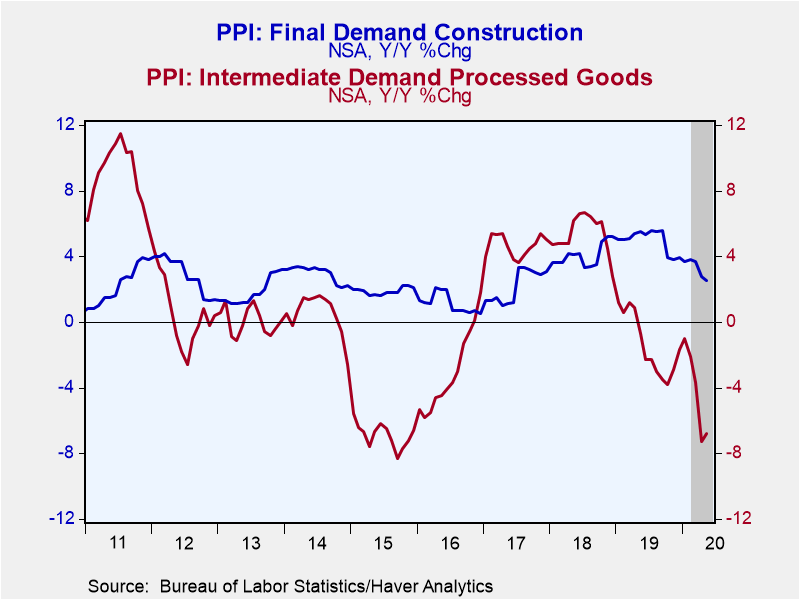 Global| Jun 11 2020
Global| Jun 11 2020U.S. Producer Price Strength Led by Food & Energy in May
by:Tom Moeller
|in:Economy in Brief
Summary
• Price index increases for first time in four months • Prices less food & energy slip. • Core goods prices hold steady while services prices ease. With industrial sector activity under pressure, pricing power remains constrained. The [...]
• Price index increases for first time in four months
• Prices less food & energy slip.
• Core goods prices hold steady while services prices ease.
With industrial sector activity under pressure, pricing power remains constrained. The Producer Price Index for final demand increased 0.4% (-0.8% y/y) during May following a 1.3% March decline. No change in the PPI had been expected in the Action Economics Forecast Survey. Underlying pricing pressure remained weak. Producer prices excluding food & energy matched expectations and eased 0.1% (+0.3% y/y), the third decline in four months. The PPI excluding food, beverages and trade services, another measure of underlying price inflation, improved 0.1% (-0.4% y/y) after a 0.9% April decline.
A 6.0% increase in food prices led the PPI higher last month as the coronavirus raised some product costs. A 69.1% jump (78.0% y/y) in beef & veal prices led the increase. Fresh fruit & melon prices strengthened 11.4% (7.1% y/y) and vegetable prices rose 2.7% (-9.7% y/y). Oilseed prices rose 2.9% (7.1% y/y). These gains were offset by a 44.0% drop (+63.8% y/y) in fresh egg prices and a 3.5% decline (-6.6% y/y) in dairy product prices.
A 4.5% rebound in energy prices also was part of the rise in producer prices last month. Gasoline prices increased 43.9% (-52.5% y/y) and natural gas prices rose 0.7% (-0.7% y/y). To the downside, home heating oil prices were off 34.6% (-65.4.7% y/y) and the cost of electric power slipped 0.3% both m/m and y/y.
Final demand goods prices less food & energy held steady in May (+0.2% y/y) after a 0.4% decline in April. The cost of finished consumer goods less food & energy improved 0.1% (1.0% y/y). Core nondurable goods prices fell 0.2% (+1.5% y/y) following years of strength. Women's apparel prices weakened 0.7% y/y but men's clothing costs rose 0.6% y/y. Durable consumer product prices improved 0.3% y/y.
For businesses, private capital equipment prices rose 0.2% last month (1.0% y/y) and reversed the prior month's decline.
Services prices for final demand slipped 0.2% in May (+0.3% y/y) for a second straight month. Trade services prices fell 0.8% (+2.7% y/y), as the cost of trade of finished goods weakened 0.9% (+2.9% y/y). A 1.5% rise (-5.4% y/y) in transportation & warehousing services prices offset the decline. Excluding these costs, prices held steady (-0.2% y/y).
The cost of construction eased 0.1% (+2.5% y/y) following a 0.5% strengthening.
Intermediate product prices edged 0.1% higher (-6.8% y/y) following a 3.7% decline.
The PPI data can be found in Haver's USECON database. Further detail can be found in PPI and PPIR. The expectations figures are available in the AS1REPNA database.
| Producer Price Index (SA, %) | May | Apr | Mar | May Y/Y | 2019 | 2018 | 2017 |
|---|---|---|---|---|---|---|---|
| Final Demand | 0.4 | -1.3 | -0.2 | -0.8 | 1.7 | 2.9 | 2.3 |
| Excluding Food & Energy | -0.1 | -0.3 | 0.2 | 0.3 | 2.1 | 2.6 | 1.9 |
| Excluding Food, Energy & Trade Services | 0.1 | -0.9 | -0.2 | -0.4 | 2.0 | 2.9 | 2.1 |
| Goods | 1.6 | -3.3 | -1.0 | -3.3 | 0.4 | 3.4 | 3.4 |
| Foods | 6.0 | -0.5 | 0.0 | 6.9 | 1.8 | 0.2 | 1.2 |
| Energy | 4.5 | -19.0 | -6.7 | -26.0 | -4.4 | 10.1 | 10.6 |
| Goods Excluding Food & Energy | 0.0 | -0.4 | 0.2 | 0.2 | 1.4 | 2.5 | 2.2 |
| Services | -0.2 | -0.2 | 0.2 | 0.3 | 2.2 | 2.6 | 1.8 |
| Trade Services | -0.8 | 1.6 | 1.4 | 2.7 | 2.5 | 1.8 | 1.5 |
| Construction | -0.1 | 0.5 | 0.1 | 2.5 | 4.9 | 4.1 | 2.2 |
| Intermediate Demand - Processed Goods | 0.1 | -3.7 | -1.1 | -6.8 | -1.4 | 5.4 | 4.7 |
Tom Moeller
AuthorMore in Author Profile »Prior to joining Haver Analytics in 2000, Mr. Moeller worked as the Economist at Chancellor Capital Management from 1985 to 1999. There, he developed comprehensive economic forecasts and interpreted economic data for equity and fixed income portfolio managers. Also at Chancellor, Mr. Moeller worked as an equity analyst and was responsible for researching and rating companies in the economically sensitive automobile and housing industries for investment in Chancellor’s equity portfolio. Prior to joining Chancellor, Mr. Moeller was an Economist at Citibank from 1979 to 1984. He also analyzed pricing behavior in the metals industry for the Council on Wage and Price Stability in Washington, D.C. In 1999, Mr. Moeller received the award for most accurate forecast from the Forecasters' Club of New York. From 1990 to 1992 he was President of the New York Association for Business Economists. Mr. Moeller earned an M.B.A. in Finance from Fordham University, where he graduated in 1987. He holds a Bachelor of Arts in Economics from George Washington University.










